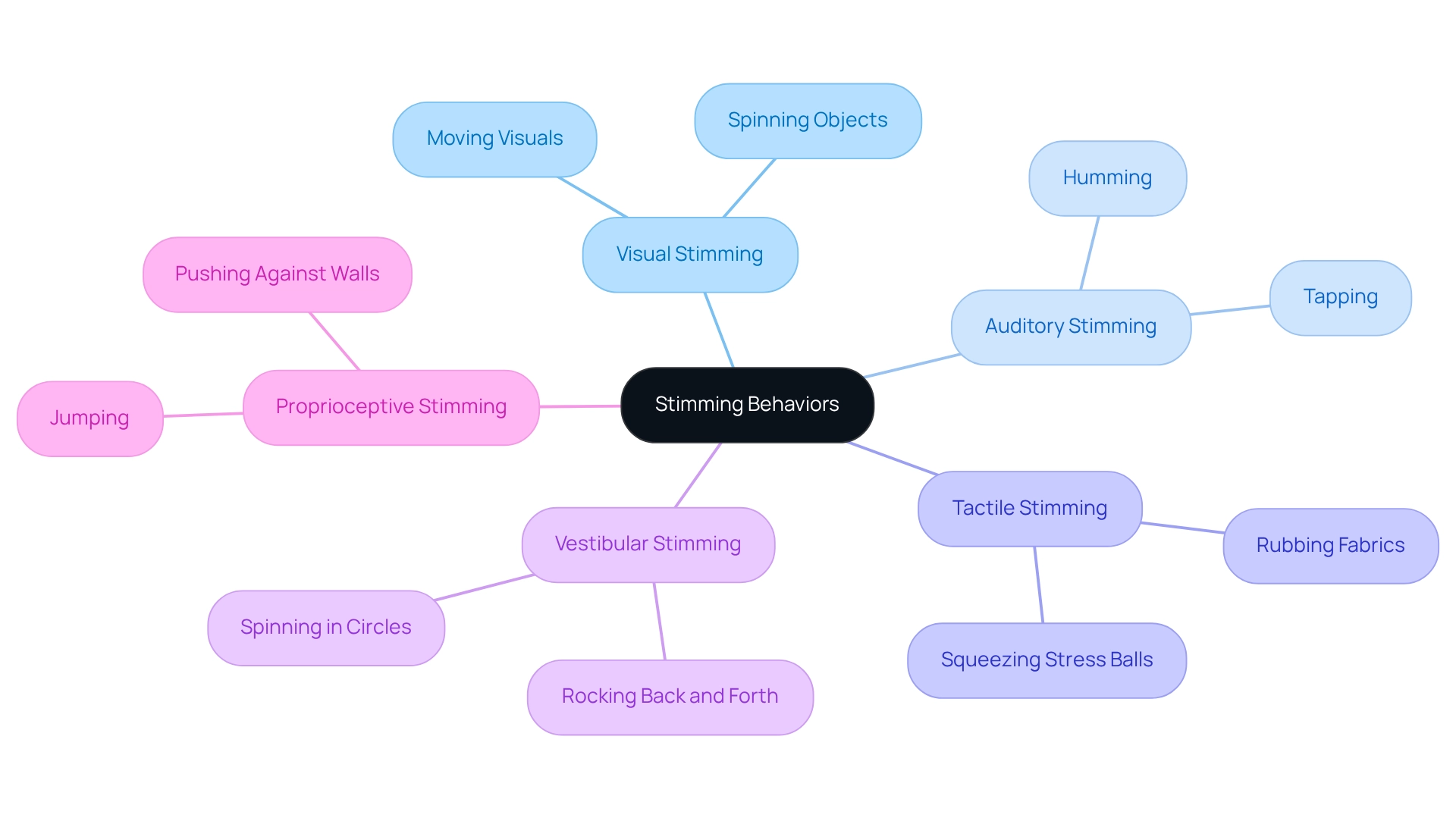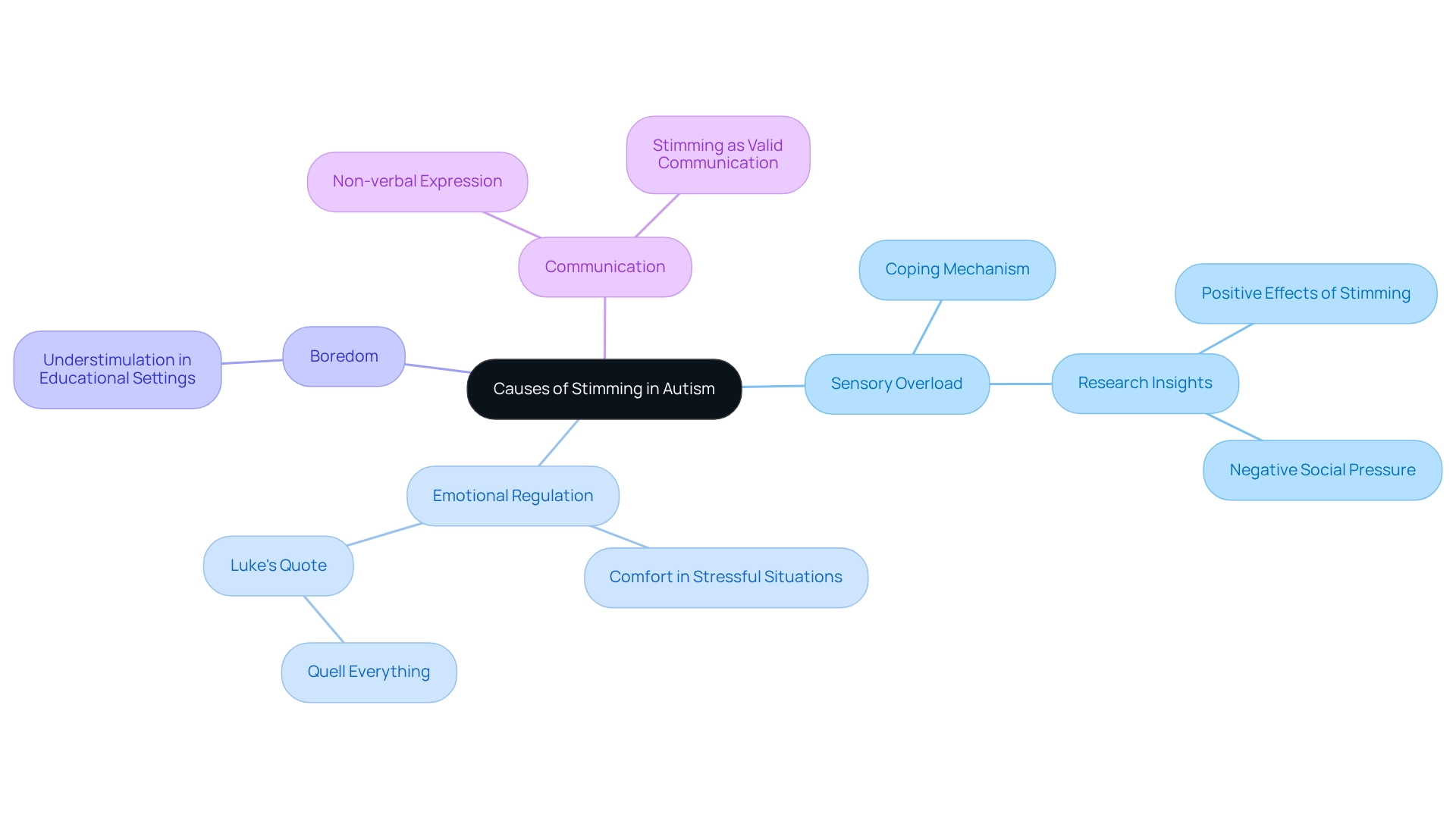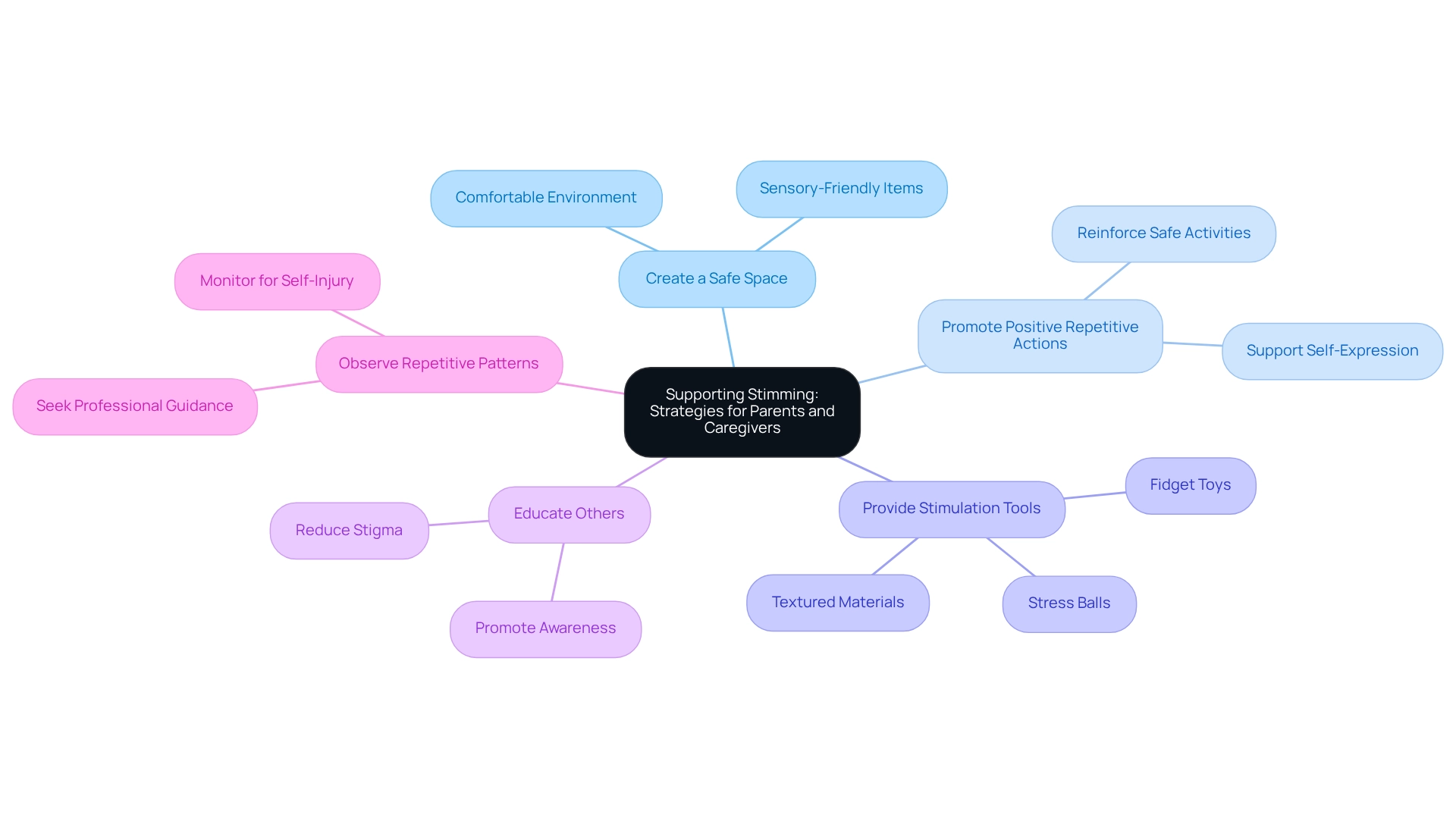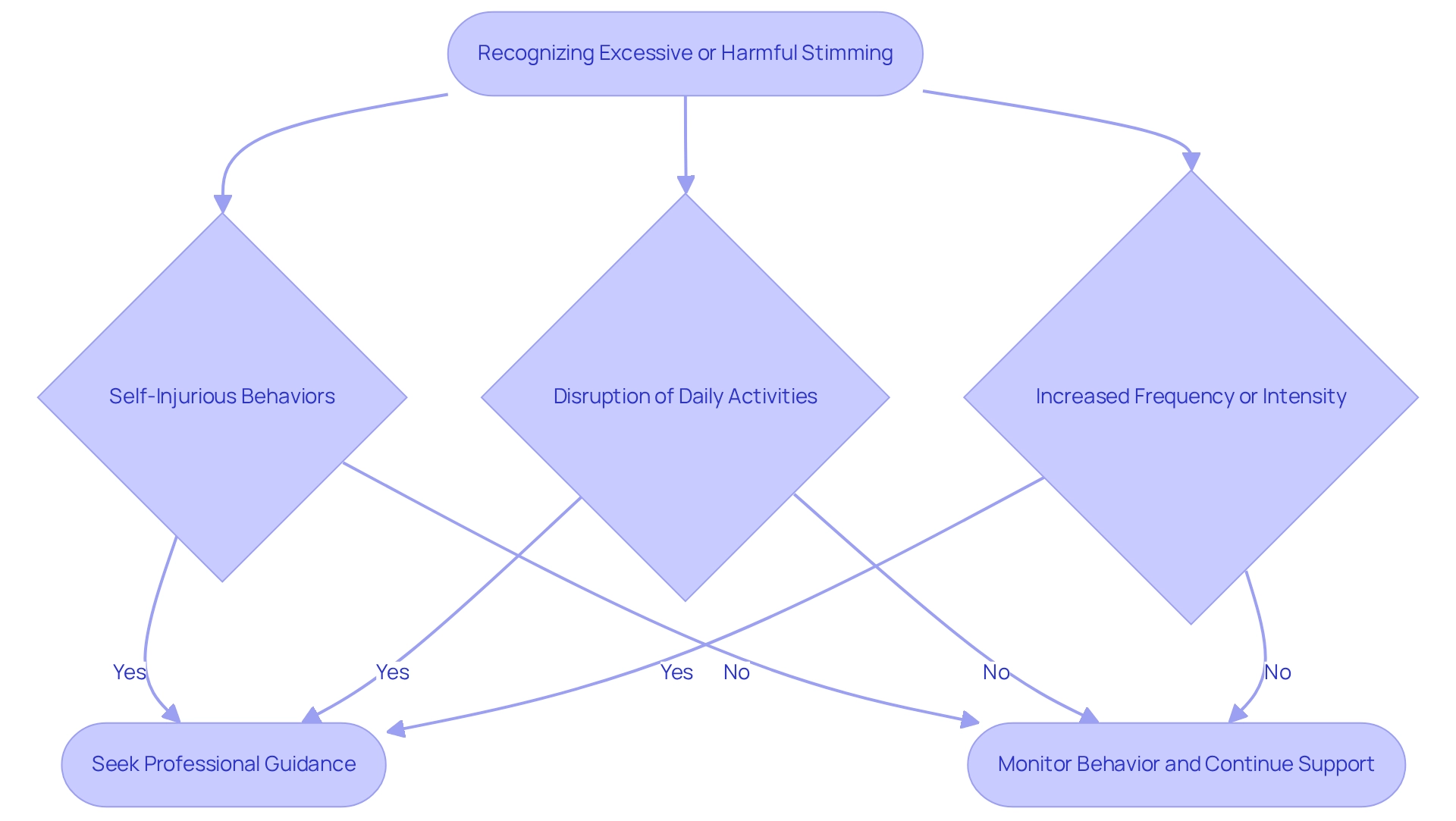Overview
This article delves into the essential understanding and management of autistic self-stimulatory behaviors, commonly referred to as stimming. For individuals on the autism spectrum, stimming serves as a vital coping mechanism, offering comfort and relief. It’s important to recognize that stimming is not merely a behavior to be controlled; rather, it is a crucial strategy for emotional regulation and sensory processing. Research supports the prevalence of stimming and highlights its positive impact on the well-being of autistic individuals.
As parents, you may find yourself concerned about your child’s stimming behaviors. It can be helpful to view these actions through a compassionate lens, acknowledging their role in helping your child navigate the world. Imagine a moment when your child uses stimming to calm themselves in a crowded environment; this is a testament to their resilience and adaptability.
Understanding stimming opens the door to providing better support for your child. Instead of viewing these behaviors as problematic, consider them as opportunities for connection and communication. By embracing stimming, you can foster an environment where your child feels safe and understood.
We invite you to share your experiences and thoughts in the comments or through our newsletter. Together, we can create a supportive community that values the unique journeys of every autistic individual.
Introduction
In a world increasingly prioritizing understanding and acceptance of neurodiversity, stimming—self-stimulatory behavior—emerges as a vital topic of discussion, especially for individuals on the autism spectrum. Characterized by repetitive movements or sounds, stimming serves essential functions such as self-soothing and emotional regulation. It offers a glimpse into the unique ways individuals navigate their sensory experiences.
As research highlights the prevalence and significance of these behaviors, it becomes crucial for caregivers, educators, and society at large to recognize stimming not merely as a quirk to be managed, but as an important aspect of emotional expression and coping strategies.
This article delves into the intricacies of stimming, exploring its definitions, types, underlying causes, and the profound impact it has on the lives of those who engage in it. Ultimately, it advocates for a more informed and supportive approach to this often-misunderstood behavior, inviting readers to foster compassion and understanding in their communities.
Defining Stimming: What It Is and Why It Matters
Stimming, or autistic self-stimulatory behaviors, encompasses a range of repetitive movements or sounds that individuals, particularly those on the autism spectrum, may engage in. Common forms of self-stimulatory behavior include hand-flapping, rocking, and vocalizations. These actions serve various purposes, such as self-soothing, managing anxiety, and expressing excitement or joy.
Understanding autistic self-stimulatory behaviors is crucial as it sheds light on the unique ways individuals with autism interact with their environment and cope with overwhelming sensory input. Research shows that these behaviors can positively impact coping mechanisms and self-efficacy, especially among autistic adults. For instance, a case study titled "Noisy Thoughts and Emotional Dysregulation" highlighted that self-stimulatory behavior often emerges in response to intrusive thoughts or intense emotions, fulfilling both communicative and regulatory roles.
Participants noted that self-stimulatory behavior could be instinctual or intentionally regulated, with some individuals using it proactively to prevent emotional dysregulation.
Statistics reveal that approximately 80% of individuals with autism engage in self-stimulatory actions, underscoring its prevalence and importance. Experts emphasize that recognizing self-soothing behaviors as natural and beneficial can empower caregivers to provide better support. By understanding the internal aspects of stimming—such as sensory sensitivities and cognitive rigidity—caregivers can create environments that nurture these behaviors, ultimately enhancing the well-being of their loved ones.
Incorporating insights from autism professionals makes it clear that autistic self-stimulatory behaviors are not merely actions to control; they are vital for self-regulation and emotional expression for many individuals on the spectrum. As one expert noted, grasping the significance of these behaviors is essential as they reflect a person’s needs and experiences. Additionally, Rebecca, a parent advocate, emphasized, "But, they should because they’re my family," highlighting the importance of supporting these behaviors within family dynamics.
By fostering an environment that appreciates and supports self-stimulatory behaviors, caregivers can significantly improve the quality of life for individuals with autism. Furthermore, understanding the internal factors influencing self-stimulatory behavior and advocating for future research into its relevance for both autistic and non-autistic individuals can aid caregivers in their approaches, ensuring they are informed and equipped to support their loved ones effectively.
Exploring the Different Types of Stimming Behaviors
Stimming behaviors, or self-stimulatory actions, play a vital role in helping individuals navigate their sensory experiences. Understanding these behaviors is essential, as they serve not only as coping strategies but also significantly contribute to emotional regulation and sensory processing. Let's explore the various types of stimming together, each with its unique purpose:
- Visual Stimming: Engaging with lights or patterns, such as spinning objects or watching moving visuals, can bring comfort. For example, a child might find solace in observing a spinning top or the gentle flicker of a light.
- Auditory Stimming: This involves making repetitive sounds, like humming, tapping, or vocalizations. Children often delight in the rhythm of tapping their fingers or the soothing melody of a favorite tune.
- Tactile Stimming: Touch is at the heart of tactile stimming, which may include rubbing different fabrics, squeezing stress balls, or playing with textured toys. These activities provide calming or stimulating tactile feedback.
- Vestibular Stimming: Movements that involve balance and spatial orientation, such as rocking back and forth or spinning in circles, can help individuals manage their perceptions and feel a sense of movement.
- Proprioceptive Stimming: Activities that offer feedback to the body, like jumping, pushing against walls, or engaging in heavy lifting, can assist individuals in feeling centered and aware of their body within the environment.
Around 90% of participants in Study 2 masked their stimming behaviors for external reasons, highlighting the prevalence and significance of these actions in the lives of autistic individuals. As Isabelle F Morris from the Institute of Child Development, University of Minnesota, emphasizes, recognizing the importance of these behaviors is crucial for effective intervention.
Ongoing investigation into autistic self-stimulatory behaviors is essential for creating personalized interventions that address the processing differences often linked with autism. Recent studies, including the insightful case study titled "Reconceptualizing Autistic Stimming," advocate for recognizing the positive roles of stimming and stress the necessity for further research in collaboration with the autistic community.
Moreover, the inclusion of perceptual processing differences in the DSM-5 diagnostic criteria underscores the relevance of this discussion, emphasizing the need for specialized evaluation and treatment. Together, we can foster a deeper understanding and support for individuals navigating these experiences.

Understanding the Causes of Stimming in Autism
Stimming actions, often referred to as autistic self-stimulatory behaviors, play a crucial role in how individuals with autism navigate their emotions and surroundings. These behaviors can arise from various sources, each contributing to their unique experiences.
Sensory Overload: For many, stimming serves as a coping mechanism to manage overwhelming sensory input. Research indicates a strong connection between sensory sensitivities and these self-stimulatory behaviors. Autistic adults frequently share that engaging in stimming offers relief from discomfort. A recent study highlights that while some may view these actions negatively, they can also yield beneficial effects, challenging the notion that they should be suppressed.
Emotional Regulation: Stimming is essential for emotional regulation, providing comfort in stressful situations. When faced with anxiety or frustration, repetitive movements or sounds can help individuals regain a sense of control and calm. Experts suggest that these behaviors are not merely quirks but vital strategies for managing emotions. As Luke expressed, repetitive actions can help individuals 'quell everything, because you’re at the same rhythm with everything,' showcasing their soothing nature.
In environments lacking adequate engagement, boredom or understimulation can lead to self-soothing behaviors. This is particularly relevant in educational settings where the pace may not align with a person's needs, prompting them to seek stimulation through these actions.
Communication: For some individuals, self-stimulatory behavior may serve as a non-verbal form of expression, especially when verbal communication is challenging. This highlights the importance of recognizing these behaviors as valid communication methods rather than practices to be discouraged.
Understanding these causes is vital for caregivers and advocates, enabling them to provide appropriate support and create environments where individuals feel safe to express themselves. Research on the social acceptance of repetitive movements reveals that while these actions are often embraced in childhood, they may face stigma during adolescence and adulthood. Participants have shared feelings of diminishment when asked to stop self-soothing behaviors, with one individual, Clive, noting it felt like being treated as if he were 'five' again.
This underscores the necessity for societal acceptance and understanding. Recognition from peers and family is crucial in allowing individuals to stim freely, fostering a supportive atmosphere that acknowledges the complexities of these behaviors. Future research should focus on behavioral phenotyping and treatment effectiveness to deepen our understanding of the implications of autistic self-stimulatory behaviors.

The Role of Stimming in Emotional and Sensory Regulation
Autistic self-stimulatory behaviors, often referred to as stimming, play a vital role for individuals with autism by aiding in emotional regulation and managing sensory perceptions. When faced with anxiety or excitement, these self-soothing behaviors can provide a much-needed calming effect, allowing individuals to regain a sense of control. Additionally, stimming is significant in processing sensory information, helping to filter out overwhelming stimuli and create a more manageable sensory environment.
Research shows that these self-soothing actions are not just repetitive tasks; they are essential coping mechanisms. For example, the study 'Exploring Stimming Patterns and Emotions' highlights the connection between specific repetitive actions and emotional states. This connection opens the door for further exploration into how these behaviors support emotional recognition and regulation. With its thoughtful design, the study offers a deeper understanding of how various stimming behaviors correlate with emotional experiences, paving the way for future research on the emotional dimensions of these behaviors in autistic individuals.
Experts advocate for viewing autistic self-stimulatory behaviors as healthy coping strategies rather than something to be eradicated. Matthew Siegel, M.D., points out that recognizing the positive aspects of self-stimulatory behavior can empower caregivers to better support individuals in navigating their perceptual experiences. This understanding fosters an environment where stimming is seen as a natural response to emotional and sensory challenges, ultimately enhancing the well-being of autistic individuals.
Furthermore, ongoing research is essential to delve into the roles of self-stimulatory behavior in emotional recognition and to challenge prevailing beliefs about the empathy and emotional intelligence of autistic people. By fostering a compassionate understanding of these behaviors, we can create a supportive community that values the unique experiences of individuals on the autism spectrum.
Identifying Common Triggers for Stimming Behaviors
Frequent triggers for repetitive actions in people with autism are intricate and can significantly impact their daily lives. Understanding these triggers of autistic self-stimulatory behaviors is vital for caregivers and advocates, as it enables them to offer the right support.
- Sensory Overload: Environments filled with loud sounds, bright lights, or crowded spaces often lead to overwhelming experiences. In such situations, individuals may engage in stimming as a coping strategy. This behavior, particularly autistic self-stimulatory actions, helps manage overwhelming stimuli and regain a sense of control. Research highlights that sensory processing challenges, as seen in various mouse models of ASD, emphasize the difficulties faced by individuals in processing sensory information, underscoring the need to understand these triggers.
- Emotional Stress: Situations that provoke anxiety, frustration, or even excitement can lead to heightened autistic self-stimulatory behaviors. For example, a child might begin to stim during a stressful event, like a family gathering or a change in routine, as a means of self-soothing. One individual noted, "you can enter a cycle and you can begin to really make your fingers leathery if you’re not careful," illustrating the importance of moderation in repetitive actions.
- Changes in Routine: Unexpected alterations in daily schedules can create discomfort and uncertainty, prompting individuals to seek reassurance through self-soothing behaviors. This response is particularly prevalent when transitioning between activities or encountering new experiences.
- Social Situations: Interactions with peers or unfamiliar individuals can be overwhelming, leading to self-soothing behaviors. By understanding the social dynamics at play, caregivers can better anticipate these actions and foster a supportive environment.
Recognizing these triggers allows caregivers to proactively manage autistic self-stimulatory behaviors, creating a more comfortable and compassionate atmosphere for individuals with autism. For instance, strategies such as fidget spinners or stress balls can serve as effective alternatives for sensory needs. Additionally, nurturing a non-judgmental environment where individuals feel safe to express their self-soothing behaviors can greatly enhance their emotional well-being.
Sally found solace in self-soothing techniques through resources like YouTube clips, which helped her avert panic attacks, showcasing the practical benefits of understanding these behaviors.
Supporting Stimming: Strategies for Parents and Caregivers
To effectively support stimming behaviors in children with autism, parents and caregivers can implement several key strategies that foster understanding and acceptance:
- Create a Safe Space: Establish a designated area where the individual can engage in stimming behaviors freely, without fear of judgment or interruption. This space should be comfortable and equipped with sensory-friendly items to promote relaxation and self-expression.
- Promote Positive Repetitive Actions: Reinforce repetitive activities that are safe and non-disruptive. By permitting individuals to convey themselves through these actions, caregivers can assist them in handling stress and anxiety, promoting a sense of acceptance and understanding. As noted by Steven K. Kapp, Ph.D., 'Individuals with autism argue that autistic self-stimulatory behaviors are essential coping mechanisms.'
- Provide Stimulation Tools: Equip the safe space with various stimulation tools, such as fidget toys, stress balls, or textured materials. These items can fulfill sensory needs and provide an outlet for self-regulation, which is crucial for emotional well-being.
It’s also essential to educate others—family members, friends, and educators—about the significance of autistic self-stimulatory behaviors. By promoting awareness and acceptance, caregivers can create a supportive environment that encourages positive interactions and reduces stigma. Research indicates that understanding and acceptance from others can significantly enhance the experience of those who stim, leading to improved emotional and social outcomes.
- Observe Repetitive Patterns: If these actions become severe or result in self-injury, it is crucial to seek professional guidance. Alterations in sensory behaviors may signify heightened stress, and understanding when to request assistance is vital for the welfare of the person.
Applying these strategies not only helps in managing sensory responses but also fosters a more inclusive environment where people feel appreciated and comprehended. Furthermore, a thorough support network is crucial for assisting individuals in managing sensory-motor activities efficiently.

When to Seek Help: Recognizing Excessive or Harmful Stimming
While autistic self-stimulatory behaviors, often known as sensory-seeking actions, are typically natural and serve various important functions, they can sometimes escalate to excessive or harmful levels. Recognizing the signs that these behaviors may require assistance is crucial for promoting the well-being of individuals with autism. Here are some key indicators to consider:
- Self-Injurious Behaviors: If stimming leads to physical harm, such as hitting oneself or pulling hair, it’s essential to seek professional guidance.
- Disruption of Daily Activities: When self-soothing activities interfere with daily routines, social interactions, or learning opportunities, intervention may be necessary to help the individual engage more fully in their environment.
- Increased Frequency or Intensity: A marked increase in the frequency or intensity of self-stimulatory actions, particularly in response to stress or anxiety, can signal the need for intervention. In such cases, discussing these behaviors with a healthcare expert or therapist can provide effective strategies for managing them.
Research suggests that excessive self-stimulatory actions may be linked to underlying processing issues, as seen in studies involving genetic mutations and their effects on perceptual responses. For instance, a case study on En2 mutant mice revealed hyper-responsiveness to repetitive sensory stimulation, reinforcing the connection between genetic factors and sensory processing abnormalities. This suggests that similar mechanisms might be at play in individuals with autism, highlighting the importance of understanding the root causes of repetitive behaviors.
Experts encourage parents to be observant and proactive when it comes to autistic self-stimulatory behaviors. If these actions become excessive or harmful, seeking help from mental health professionals can lead to tailored intervention strategies. As Steven K. Kapp noted, 'Future researchers could explore autistic individuals’ accounts concerning the alleged internal causes of their stims,' underscoring the need for a deeper understanding of these behaviors.
Moreover, recent discussions have highlighted the positive aspects of self-stimulatory behaviors and the importance of acceptance among autistic adults. This balanced approach enables parents and caregivers to support their children effectively, recognizing both the potential challenges and the inherent value of stimming activities.

Creating a Safe and Sensory-Friendly Environment for Stimming
Establishing a secure and sensory-friendly setting is crucial for assisting those with autism in managing their self-stimulatory actions. By creating such an environment, caregivers can truly make a difference in the lives of individuals with autism. Here are some key strategies to consider:
- Reduce Sensory Overload: To foster a calming atmosphere, it’s important to minimize loud noises, bright lights, and visual clutter. Research indicates that environments designed to limit sensory input can significantly enhance concentration and reduce anxiety for autistic individuals. Attention levels were rated based on on-task and off-task behaviors during equipment use, underscoring the importance of a well-structured environment.
- Incorporate Comfort Items: Integrating soft furnishings, weighted blankets, and calming scents into the environment can provide solace and help individuals feel more secure. This is essential for managing sensitivity issues. As Cassandra shared, "I don’t think I’d ever be able to have a job... because I’m so sensitive to smell," which highlights the real challenges faced by those with heightened sensitivities.
- Designate Stimulation Areas: Creating specific spaces dedicated to stimming activities, equipped with tactile tools such as fidget toys, textured materials, and calming resources, is beneficial. A study on Multi-Sensory Environments (MSEs) found that when children had control over equipment, they exhibited more favorable behavioral changes and improved arousal levels. This emphasizes the significance of customized sensory environments that cater to individual needs.
- Encourage Routine: Establishing predictable routines can provide a sense of security. Consistency can greatly lessen anxiety and assist individuals in navigating their environments more comfortably.
By implementing these strategies, caregivers can create sensory-friendly environments that not only support stimming behaviors but also enhance overall well-being and learning opportunities for individuals with autism. Additionally, the need for more qualitative studies that include first-person perspectives of children and youth with ASD regarding their sensory processing highlights the importance of understanding these experiences to better inform the creation of supportive environments. What strategies have you found helpful in your journey? Share your thoughts and experiences in the comments.
Conclusion
Stimming is a multifaceted behavior that plays a crucial role in the lives of individuals on the autism spectrum. It is essential to recognize that stimming is not merely a quirk but a vital aspect of emotional regulation and sensory processing. From visual and auditory stimming to tactile and proprioceptive behaviors, these actions serve essential functions, helping individuals manage anxiety, cope with sensory overload, and express emotions.
Understanding the underlying causes of stimming—such as sensory sensitivities, emotional stress, and communication needs—empowers caregivers and educators to create more supportive environments. By fostering acceptance and understanding of stimming behaviors, society can help individuals with autism navigate their unique sensory experiences without fear of judgment. This acceptance is vital not only for emotional well-being but also for promoting a sense of belonging and self-worth.
As research continues to illuminate the significance of stimming, it becomes imperative for caregivers to implement strategies that support these behaviors in safe and nurturing ways. Creating sensory-friendly environments, encouraging positive stimming, and educating others can significantly enhance the quality of life for individuals with autism. Ultimately, embracing stimming as a natural and beneficial behavior fosters compassion and understanding, paving the way for a more inclusive society that values neurodiversity. By prioritizing these approaches, communities can help individuals thrive, ensuring their voices are heard and respected.
Frequently Asked Questions
What is stimming and who typically engages in it?
Stimming, or autistic self-stimulatory behaviors, refers to a range of repetitive movements or sounds that individuals, particularly those on the autism spectrum, may engage in.
What are some common forms of self-stimulatory behavior?
Common forms of stimming include hand-flapping, rocking, and vocalizations.
What purposes do self-stimulatory behaviors serve?
These behaviors serve various purposes such as self-soothing, managing anxiety, and expressing excitement or joy.
Why is understanding stimming important?
Understanding stimming is crucial as it sheds light on the unique ways individuals with autism interact with their environment and cope with overwhelming sensory input.
How do self-stimulatory behaviors impact autistic individuals?
Research indicates that these behaviors can positively impact coping mechanisms and self-efficacy, especially among autistic adults.
What did the case study "Noisy Thoughts and Emotional Dysregulation" reveal about self-stimulatory behavior?
The case study highlighted that self-stimulatory behavior often emerges in response to intrusive thoughts or intense emotions, fulfilling both communicative and regulatory roles.
How do individuals regulate their stimming behaviors?
Participants noted that stimming can be instinctual or intentionally regulated, with some using it proactively to prevent emotional dysregulation.
What statistics reflect the prevalence of stimming among individuals with autism?
Approximately 80% of individuals with autism engage in self-stimulatory actions, underscoring its prevalence and importance.
How can caregivers support individuals who engage in stimming?
Recognizing self-soothing behaviors as natural and beneficial can empower caregivers to provide better support, creating environments that nurture these behaviors.
What types of stimming behaviors are there?
Types of stimming include visual stimming (engaging with lights or patterns), auditory stimming (making repetitive sounds), tactile stimming (touching various textures), vestibular stimming (movements involving balance), and proprioceptive stimming (activities providing body feedback).
What is the significance of masking stimming behaviors?
Around 90% of participants in a study masked their stimming behaviors for external reasons, highlighting the prevalence and significance of these actions in the lives of autistic individuals.
Why is ongoing research into stimming behaviors important?
Ongoing research is essential for creating personalized interventions that address the processing differences often linked with autism and recognizing the positive roles of stimming.
What do the DSM-5 diagnostic criteria emphasize regarding stimming?
The inclusion of perceptual processing differences in the DSM-5 underscores the relevance of stimming behaviors, emphasizing the need for specialized evaluation and treatment.




